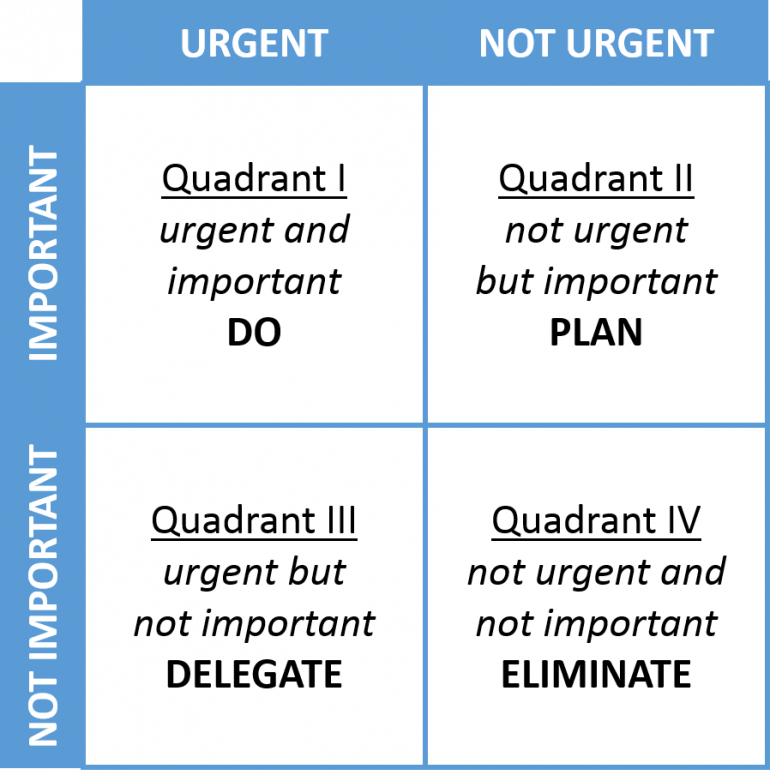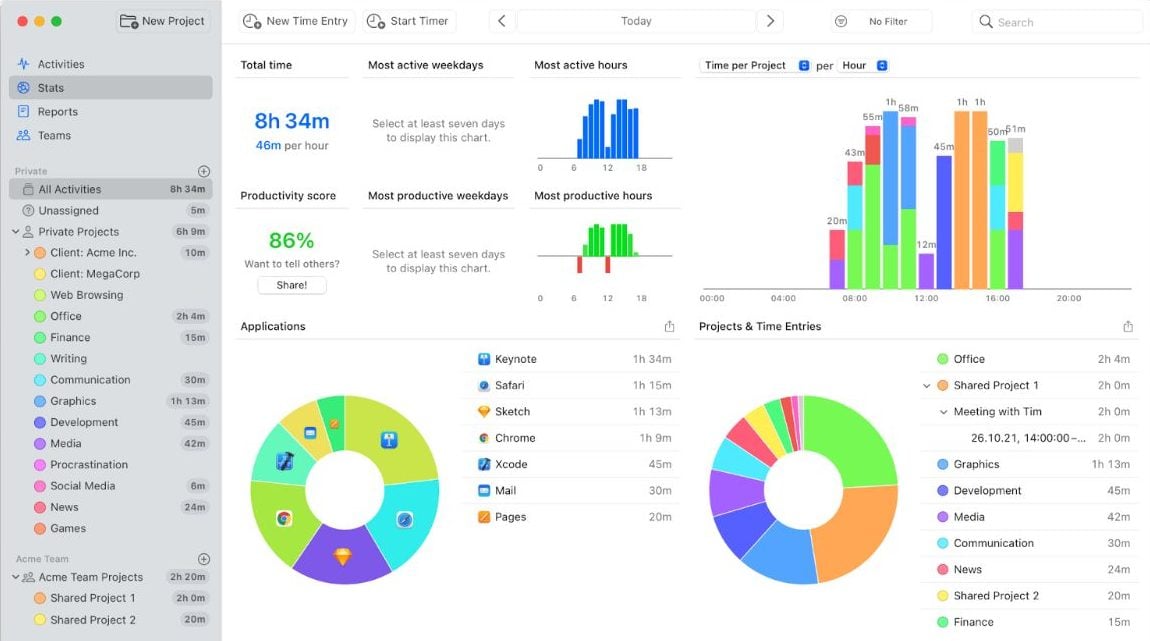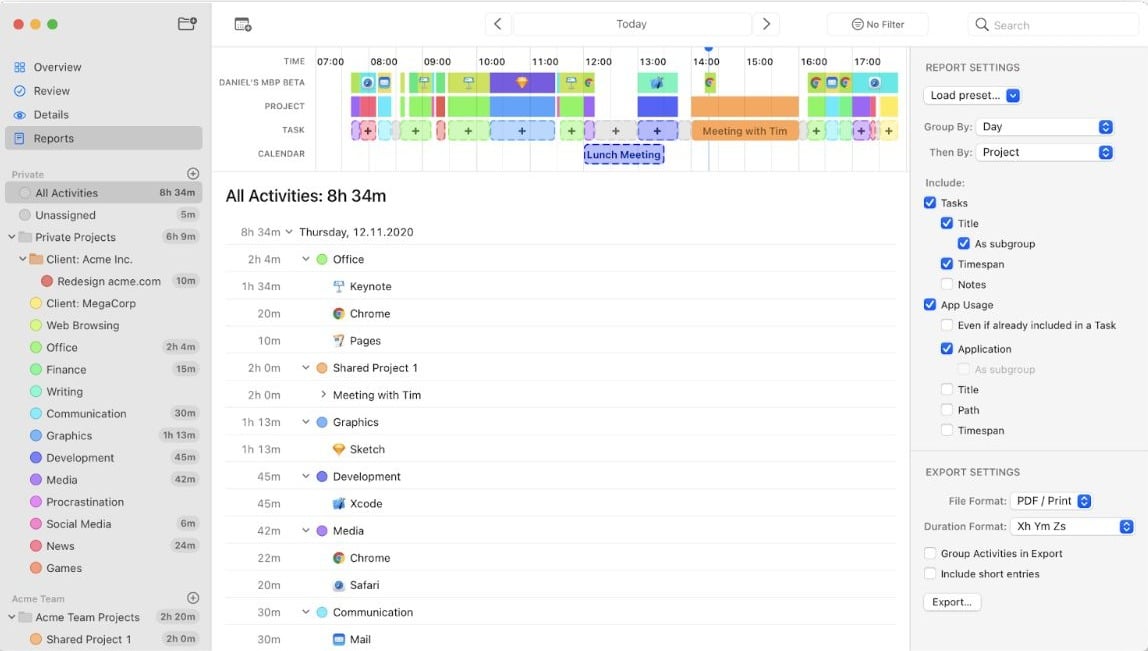Time Management Matrix: How to Focus on What’s Important

When we’re busy at work or in our personal lives, it’s easy to become overwhelmed by long lists of tasks. We often rush to check items off our to-do list, regardless of their value or timeline. This behavior feels like getting things done, even though not all tasks are the same, and most of them will never help us achieve our goals. But you can get past all that with the Time Management Matrix, which is also called the “Eisenhower Matrix”.
You see, productivity isn’t about working harder or longer – that’s poor time management. Yes, simply working more will cross more items off your list, but it rarely helps create real change in your life. That’s why productivity is more about doing the right things.
How do you work on the right tasks? With prioritization.
Prioritization seems simple, but it’s an advanced skill that few people do well. It’s hard to look at our work objectively and accept that some won’t happen, especially when we’re overwhelmed.
The Time Management Matrix is a powerful tool to organize your work based on importance and urgency. It helps you focus on the tasks that matter most and avoid the ones that don’t help you achieve your goals.
This article explains the Eisenhower Matrix, its advantages, who it’s for, and how it works. Then we offer some tips to use it well.
The Time Management Matrix is a powerful tool to organize your work based on importance and urgency. It helps you focus on the tasks that matter most and avoid the ones that don’t help you achieve your goals. Share on X
What is a Time Management Matrix?
A time management matrix is a tool used to prioritize tasks based on their level of urgency and importance. It helps individuals allocate their time effectively by categorizing tasks into four quadrants: urgent and important, important but not urgent, urgent but not important, and neither urgent nor important. The goal of a time management matrix is to focus on important tasks and minimize distractions from non-essential ones.

Image source: Wikimedia Commons
The time management matrix is also called the Eisenhower matrix after former US President Dwight D. Eisenhower. He used this method to prioritize tasks and make the most of his time in the office. The story goes that Eisenhower realized that not all jobs were equally important, so he developed a system to categorize them based on their level of urgency and importance. This system later became known as the Eisenhower matrix.
The name reflects that Eisenhower was a highly effective leader who prioritized his time and made the most of his resources to achieve his goals. Today, millions of people worldwide use the Eisenhower matrix to manage their time and be more productive.
Who Should Use the Eisenhower Matrix?
The time management matrix is a tool for anyone who wants to be more productive and efficient with their time. It is particularly helpful for individuals who struggle with prioritizing tasks and feel overwhelmed by work, school, or personal life demands.
Some groups who can benefit from using the time management matrix include:
- Professionals: The matrix can help professionals allocate their time effectively and make the most of their workday.
- Students: Students can use the matrix to prioritize their study time and manage their workload more efficiently.
- Entrepreneurs: Entrepreneurs can use the matrix to prioritize tasks and stay focused on their goals.
- Busy individuals: People who have multiple commitments and responsibilities can use the matrix to prioritize tasks and manage their time more effectively.
Advantages of the Time Management Matrix

Image source: Pexels
The Time Management Matrix isn’t a magic wand that will supercharge your productivity over time. Still, it’s a powerful tool to help you understand what matters most. Here are the main advantages of using the Time Management Matrix.
It Helps You Stay Organized
Using the time management matrix, individuals can prioritize their tasks and stay organized by focusing on the most important and urgent tasks while avoiding distractions from less critical tasks. Doing this helps make the most effective use of time, reducing stress and increasing productivity.
It Helps You Develop Planning Skills
The time management matrix is the perfect exercise if you don’t have much experience planning your tasks. It forces you to think critically about each of your tasks. Instead of evaluating your work based on how long it takes, you’ll determine it based on the value it provides.
It Identifies What’s Most Important
When you have a lot of tasks on your plate, you tend to work on the simplest tasks that reduce your perceived workload and grant dopamine hits from crossing off items from the list. But those small tasks rarely provide much value. The time management matrix helps you determine the most valuable tasks that deserve your time.
It Forces You to Automate, Delegate, and Outsource
We all know we should be using automation to take care of our small tasks, but that’s always something to handle “another day.” Create a task in your second time management quadrant to automate some other task. For instance, you might set up a Calendly account to streamline meeting setup rather than slogging through the back-and-forth emails.
The same goes for delegation and outsourcing. These are potentially cheaper than doing some tasks ourselves, but we never have the time to set them up. Add these tasks to your second quadrant to hire that virtual assistant and shift some responsibilities to someone else on your team. Some of these tasks would also be more suited to be done by a software rather than another human. For example, using an email finder tool may be faster still than having someone research these emails by hand instead.
How to Use the Eisenhower Matrix

Image source: Pexels
Using this matrix, you can prioritize tasks based on their importance and urgency, ensuring that you focus on the tasks that will bring you closer to your goals while avoiding distractions and time wasters. It works by dividing tasks into four categories based on their level of urgency and importance.
Time Management Quadrant 1: Urgent and Important
The first quadrant of the Time Management Matrix, also known as the “Urgent and Important” quadrant, refers to tasks that require immediate attention and have significant consequences if not completed promptly. These tasks are considered top priorities and require our full attention and effort.
Examples of tasks in this quadrant include:
- Responding to a crisis or emergency
- Meeting deadlines for important projects or assignments
- Attending to urgent personal or family matters
- Dealing with unexpected events or interruptions
In this quadrant, you must prioritize and allocate sufficient time to tackle the tasks at hand. Neglecting them can lead to negative consequences such as missed opportunities or decreased productivity. For example, failing to participate in an important meeting with a potential client could have serious revenue ramifications.
Effective time management in this quadrant requires an individual to focus on the task, minimize distractions and interruptions, and be proactive in anticipating and preventing potential emergencies. It also requires good organizational skills and the ability to prioritize tasks based on their level of urgency and importance.
While tasks in this quadrant are crucial, it is also essential to recognize that constantly working in this quadrant can lead to burnout, stress, and decreased overall productivity. If you want to avoid this, it is essential to balance time spent in this quadrant with time spent in other quadrants, such as the “Important but Not Urgent” quadrant, to ensure a more sustainable and practical approach to time management.
Quadrant 2: Important, Not Urgent
The second quadrant of the Time Management Matrix, also known as the “Important but Not Urgent” quadrant, refers to tasks that are important for achieving long-term goals and personal or professional development but do not have a pressing deadline.
These tasks often fall into the category of “preventive maintenance.” They are often neglected in favor of more immediate and urgent tasks, even though they often provide the most value to your business and personal life.
Examples of tasks in this quadrant include:
- Planning and setting long-term goals
- Engaging in continuous learning and personal development
- Building and maintaining relationships
- Taking care of physical and mental health through exercise and self-care
- Performing “deep work” activities
In this quadrant, it is crucial to allocate sufficient time and effort to these tasks, as neglecting them can lead to negative consequences in the long term. For example, failing to engage in continuous learning can lead to being left behind in one’s field or industry, while neglecting physical and mental health can lead to decreased productivity and decreased overall well-being.
Effective time management in this quadrant requires an individual to prioritize and allocate time for these important but not urgent tasks and to develop habits and routines that make them a regular part of one’s routine. You can do this by setting aside dedicated time for uninterrupted work, scheduling regular check-ins with your colleagues, or dedicating time each week to learning and development.
It is also worth recognizing that while these tasks may not have an immediate deadline, they are no less critical than tasks in other time management quadrants. Investing time and effort in this quadrant can improve your overall well-being, achieve long-term goals, and increase your productivity and effectiveness.
Quadrant 3: Urgent, Not Important
Inside the third quadrant of the Time Management Matrix are the “Not Important but Urgent” tasks. These tasks have an immediate deadline or sense of urgency but do not contribute to achieving long-term goals or personal or professional development. These tasks are often called “time-wasters” and can distract from more important duties and responsibilities.
Examples of tasks in this quadrant include:
- Replying to non-urgent emails or phone calls
- Participating in unimportant meetings
- Engaging in excessive social media or internet use
- Engaging in aimless or unproductive activities
In this quadrant, it is vital to minimize the time spent on these tasks and to be mindful of the potential distractions they can cause. You can do this through batch processing email or phone calls, declining unimportant or non-urgent invitations, and setting limits on social media or internet use.
Effective time management in this quadrant requires an individual to recognize the difference between important and unimportant tasks and prioritize them based on their value. For many freelancers and teams, this often means delegating tasks to someone else, outsourcing external services, chunking them together to take less time (called time batching), or automating them with software.
Individuals can increase their overall productivity, reduce stress and distractions, and achieve their long-term goals and personal and professional development by minimizing the time spent on tasks in this quadrant. However, it is also important to recognize that some tasks in this quadrant may still be moderately necessary and to balance the time spent on them with the time spent on more important tasks.
Quadrant 4: Not Urgent, Not Important
The fourth quadrant of the Time Management Matrix includes “Not Important and Not Urgent” tasks. These tasks have neither an immediate deadline nor contribute to achieving long-term goals or personal or professional development. These tasks are often referred to as “time-wasters” or “time-killers” and can harm overall productivity and well-being.
Examples of tasks in this quadrant include:
- Engaging in excessive television or movie watching
- Engaging in non-essential shopping or leisure activities
- Participating in low-value social events or gatherings
- Engaging in aimless or unproductive activities
In this quadrant, it is important to minimize the time spent on these tasks and to be mindful of the potential distractions they can cause. You can achieve this by setting limits on leisure activities, declining non-essential social invitations, and engaging in more productive and fulfilling activities.
Effective time management in this quadrant means recognizing the tasks that don’t add value and probably aren’t worth doing at all, even if you delegate them to someone else. Working on these tasks most likely prevents you from completing more meaningful tasks. You can eliminate these tasks from your to-do list in most cases.
One important note: Don’t lump all leisure or pleasurable activities in this category just because they don’t support your work or personal development. Having fun and spending unstructured time with your family and loved ones have a lot of value, which means they don’t belong in this fourth quadrant.
5 Tips to Use the Time Management Matrix

Image source: Pexels
Now that you understand how the Eisenhower Matrix works, let’s talk about ways to get the most value out of it. Like all tools, you need to learn how to use it effectively. Here are some tips for using the Matrix well.
1. Identify Your Priorities
To sort your tasks by importance and urgency, you must understand the highest priorities in your line of work. Fortunately, these tasks are easy to identify. They’re the ones that help you achieve your goals and move you forward in your career.
For instance, you might decide that serving your existing clients is your highest priority. Nothing else should happen until you meet those deliverables. Failing to serve your clients well could jeopardize those relationships and cause damage to your business and income.
On the other hand, attending networking events is important but never urgent. You would never neglect your clients to participate in an industry event. So while networking deserves some time in your schedule, it’s always second place to your clients.
One smart way to identify your priorities and your time spent is through time tracking. In Timing, you can view detailed analytics about how you spend your time on individual tasks. You can also drill down to the client and project level for a granular view.

2. Learn to Categorize Quickly
Your Time Management Matrix is a living document. You will add and remove tasks continuously over time. So it’s vital to learn how to categorize your tasks quickly. A good rule of thumb is to ask yourself two questions:
- “Does this task directly support my goals?”
- “Will I suffer significant consequences if I fail to complete this task soon?”
If you answer yes to both questions, the task belongs in the first quadrant. If you answer yes to the first question and no to the second, the task belongs in quadrant two. If you answer no to the first question and yes to the second, it belongs in quadrant three. And if you answer no to both questions, the task belongs in quadrant four.
Over time, you won’t have to think about this much. In fact, after using the time management matrix for a while, you’ll find yourself only using the first two quadrants. Anything in quadrant three will get immediately handed off to someone else, and anything that would go in quadrant four will get pushed out of your mind.
3. Schedule Time for Uninterrupted Work
Generally speaking, more time spent working in the second quadrant (important but not urgent) means less time you’ll spend solving problems and responding to emergencies in the first quadrant (important and urgent). Simply put, if you are well prepared and always working ahead, there won’t be as many problems and emergencies to solve.
In other words, even if first-quadrant work seems infinite, scheduling uninterrupted time every day for second-quadrant work is essential. It’s the only way to get ahead. Put some space on your calendar for deep work, periods where you’re allowed to focus on tasks for an extended period without being distracted or pulled elsewhere.
4. Automate, Delegate, and Outsource
If you are to have time for your second quadrant work, it’s crucial to shift as many of your responsibilities as possible to other people or systems.
- Automate basic tasks that software can do. Yes, some tools come with a cost, but that is usually less than the cost of your time. For instance, Timing can help you save hours by automating your time tracking. Check out our automation features.
- If your skills and expertise aren’t necessary for a particular task, delegate it to someone on your team. Look for people who have time in their schedule and can complete the tasks satisfactorily.
- Outsource anything that can’t be automated or delegated. Countless freelancers, virtual assistants, and agencies can handle any task on your plate.
Review your activity log in a tool like Timing to find tasks you can automate, delegate, or outsource. Look for essential tasks that occur often but aren’t subject to tight deadlines. (Check out some other ways Timing can help with your time management.)

5. Use Distraction Blockers
If you spend too much time on pointless activities, consider using anti-distraction tools to block certain websites, apps, or platforms from your devices during work hours. These aren’t perfect solutions because you always have the power to turn them off, but they can block the initial impulse to engage in time-wasting activities.
Time Management Matrix Frequently Asked Questions
We’ve explained the time management matrix, why you should use it, and how it works, but you may have some questions. Here are some commonly asked questions about the time management matrix.
How do I determine which tasks fall into which category of the matrix?
Deciding which tasks fall into which category of the Time Management Matrix involves assessing their level of urgency and importance. Here’s a simple process:
- Urgency: Urgency refers to the time constraint for completing a task. Tasks that require immediate attention or have a pressing deadline are considered urgent.
- Importance: Importance refers to a task’s impact on your long-term goals and priorities. Tasks that contribute to your success and well-being are considered important.
- Evaluate each task: Start by evaluating each of your tasks based on their level of urgency and importance. Consider factors such as the deadline, the potential consequences of not completing the task, and its impact on your goals.
- Assign each task to a category: Based on your evaluation, assign each task to one of the four categories of the Time Management Matrix: Urgent & Important, Important but Not Urgent, Urgent but Not Important, and Not Urgent or Important.
- Prioritize tasks: Use the Time Management Matrix to prioritize your tasks based on their urgency and importance. Tackle tasks in the Urgent & Important category first, then move on to tasks in the Important but Not Urgent category, and so on.
Can you provide examples of tasks that would fall into each matrix category?
Examples of first quadrant tasks:
- Meeting deadlines for a project at work or school
- Answering an urgent email from a client or boss
- Dealing with a personal crisis or emergency
- Responding to a critical customer support request
Examples of second quadrant tasks:
- Investing time in professional development and learning new skills
- Strategizing or planning future projects
- Building and maintaining meaningful relationships with friends and family
- Exercising and maintaining a healthy lifestyle
- Working on personal goals and aspirations, such as writing a book or starting a business.
Examples of third quadrant tasks:
- Answering non-critical phone calls or emails
- Participating in time-sensitive but unimportant meetings
- Completing busy work or tasks that don’t align with your goals
- Reacting to unexpected interruptions or distractions
- Any simple task that you do regularly or takes up a lot of time
Examples of fourth quadrant tasks:
- Spending excessive time on social media or browsing the internet
- Watching television or streaming video content for hours on end
- Participating in unproductive or time-wasting activities, such as playing video games
- Engaging in negative self-talk or dwelling on problems without taking action
Why is time management so important?
Time management is important because it allows individuals to prioritize and allocate their time effectively, leading to increased productivity, reduced stress, and better achievement of personal and professional goals. It also helps to ensure that you complete essential tasks, meet deadlines, and that adequate time is available for rest and leisure activities.
Consistency Creates Progress
The time management matrix is one methodology to organize your work and focus on the activities that provide the most value. However, it’s not the only time management technique. There are other tools you can use to guide your task prioritization.
What’s important is finding the methodology that works best for your needs and sticking to it. Consistency is critical.
